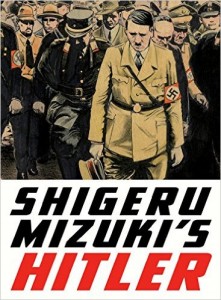By Shigeru Mizuki. Released in Japan as “Gekiga Hitler”by Jitsugyou no Nihonsha, serialized in the magazine Manga Sunday. Released in North America by Drawn and Quarterly.
It saddens me to be writing this review now that Mizuki has passed on, but I am pleased that his work is still coming out to entertain and fascinate us all. Showa just completed, we have this new Hitler volume, and Kitaro finally gets a broader release in 2016. He spent his life creating works that will remain behind long after his death. And that includes this book, which was called something like Hitler: The Graphic Novel in Japan, but has been retitled here. And it fits, as the Hitler we’re seeing here feels more like Mizuki’s than it does history’s. This isn’t to say that Mizuki hasn’t done his research: everything is carefully couched in the history that we know (which is not as much as we’d like to). But as the book goes on and we dig deeper and deeper into the darkness of Hitler and the Nazi party, he becomes his own caricature.
We start off with Hitler as a starving artist, not looking unlike what Kitaro might look if he grew up. Those familiar with Showa will know what we’re getting here, though he did this work first: a combination of historical textbook mixed with dramatized scenes. The dialogue not taken directly from Hitler’s speeches is very perfunctory and drab, deliberately so, I believe: these are real human beings deciding to commit all these atrocities in the name of power, and it wouldn’t do to make their evil more grandiose than it needs to be. As the book goes on, we continue to see Hitler’s rise to power and eventual realization, during World War II, that he’s on the losing side. Most of the major points are kept: his disturbing relationship with his niece, his failing health towards the end, his power of rhetoric swaying opinions – and when that doesn’t work, killing anyone who opposes him.
The introduction notes that Western readers might be surprised at how little the Holocaust was mentioned. I was *very* surprised – it gets one page, right near the end, but other than that and Hitler ranting about Jews a few times in the first half of the book, we get almost nothing about concentration camps or anything else – most of the WWII history is confined to troop movements and leadership positions. To be fair, there are a LOT of famous people in this book, and Mizuki wants to keep it simple by focusing on the politicians he’s sure Japanese readers will know. Still, it’s a startling gap in the book.
The best reason to read this book is Mizuki’s art, in particular his facial expressions. This has always been a strong point of Mizuki’s, but it’s almost sublime here, as his Hitler’s desperate, snorting face gives the pent-up emotion that the dry dialogue can’t necessarily carry. (Some of the funniest moments have Hitler reacting to horrible events with a simple “gyah!”.) Goebbels in particular is amazing, as Mizuki decides about 3 pages after his introduction to try to draw him like some sort of twisted Picasso face, attempting to slide off the page every time we look at it. It’s so fitting for Goebbels that I can’t help but laugh. Each caricature looks like the man portrayed, yes also exaggerates them to ridiculous heights.
If you’re looking for a good overview of Hitler’s rise to power, I think there are better books. But for a book showing us Shigeru Mizuki’s unique take on Hitler, and his ability to show off the man’s unique evil in his own style, this is a great choice. Also for amusement, try to add up the times we see Hitler doing the standard “Mizuki snort of rage” pose.


Speak Your Mind